The Best Infrared Thermometers in 2024 Tested and Reviewed
Carefully graded and selected by our reviewers to be the best in terms of performance, design, and usability, you’ll be able to see which models are the best infrared thermometers here!
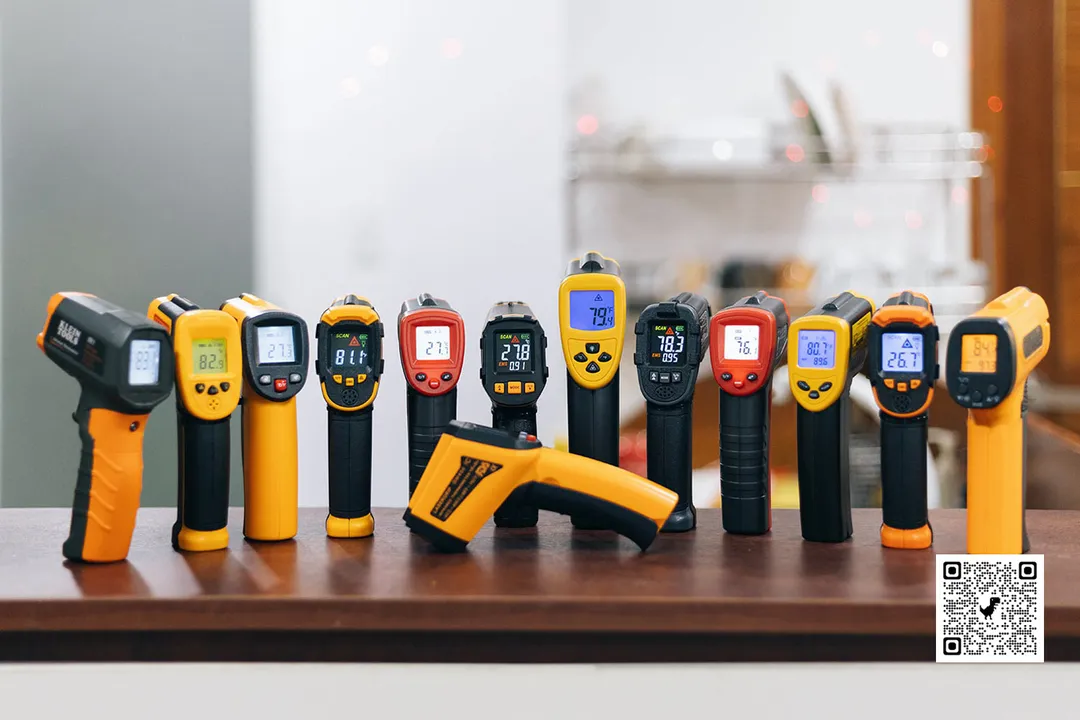
Any well-stocked kitchen should have a good thermometer on standby in a cupboard somewhere. With an IR thermometer, you can immediately learn the temperature of nearly any object simply by pointing the thermometer at its surface and pressing the trigger. These non-contact thermometers make your temperature estimations on everything from stovetops to BBQ grills much safer and easier.
What’s the Use of an Infrared Thermometer in a Kitchen?
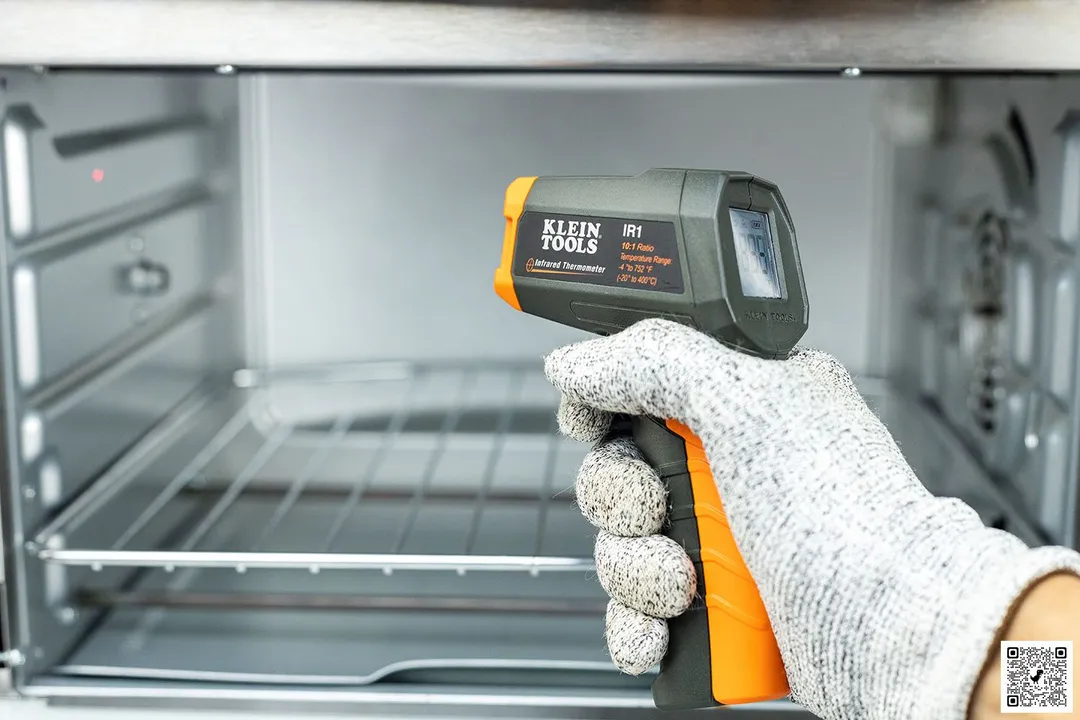
Objects, including our bodies, emit thermal radiation. This radiation is often in the form of infrared (IR) light, which is invisible but detectable with specialized tools like IR thermometers. These devices can translate the intensity of this radiation into temperature readings, allowing you to read the temperature of any object and surface without touching it.
In the kitchen, IR thermometers offer a safe and convenient way to measure the surface temperatures of various kitchen appliances like stovetops, ovens, and grills. But unlike other kinds of thermometers, like wired probe thermometers, you don’t need to touch the hot surfaces, making it much safer to use. However, they cannot measure the internal temperature of food. For example, if you need to check the core temperature of poultry, meat thermometers should be used.
How We Test
The performance of each IR thermometer is assessed using two tests: a cold test and a hot test.
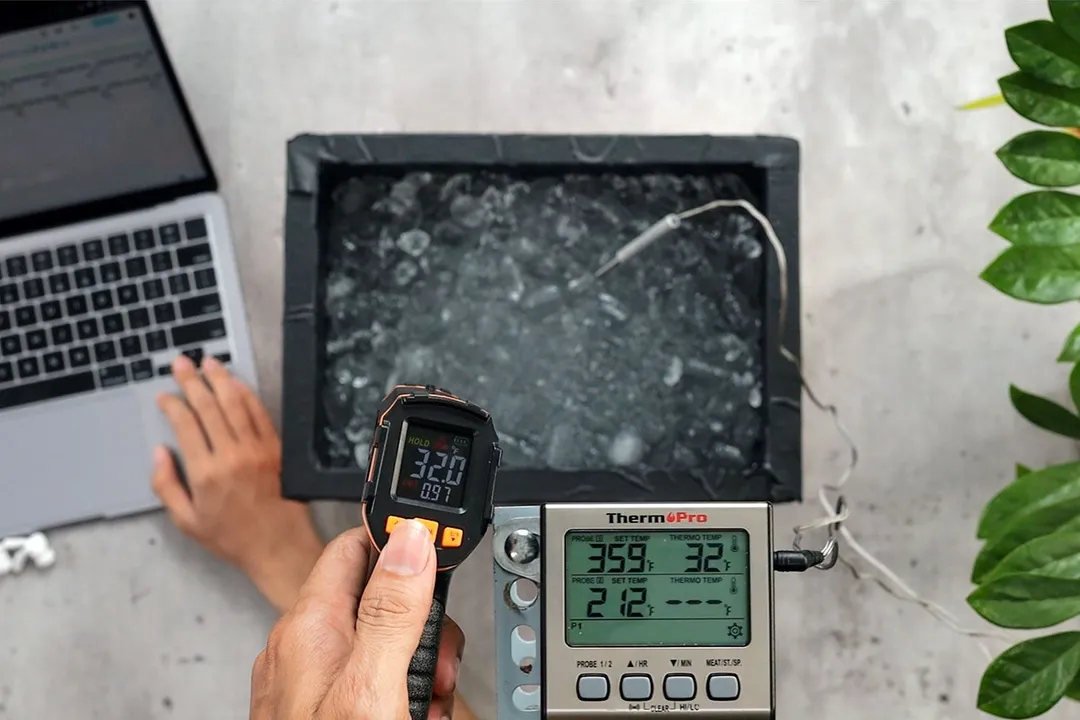
The first test, known as the cold test, involved ice. We filled an insulated box with icy water and waited until the temperature stabilized at 32°F. To ensure accuracy, we used a temperature probe to measure this temperature. Once the water hit the proper temperature, we took IR-thermometer temperature readings at two distances: 12 inches and 16 inches from the surface.
We then compared these readings to the temperature of the ice. The scores were based on how closely the IR thermometer was to that actual value of 32°F.
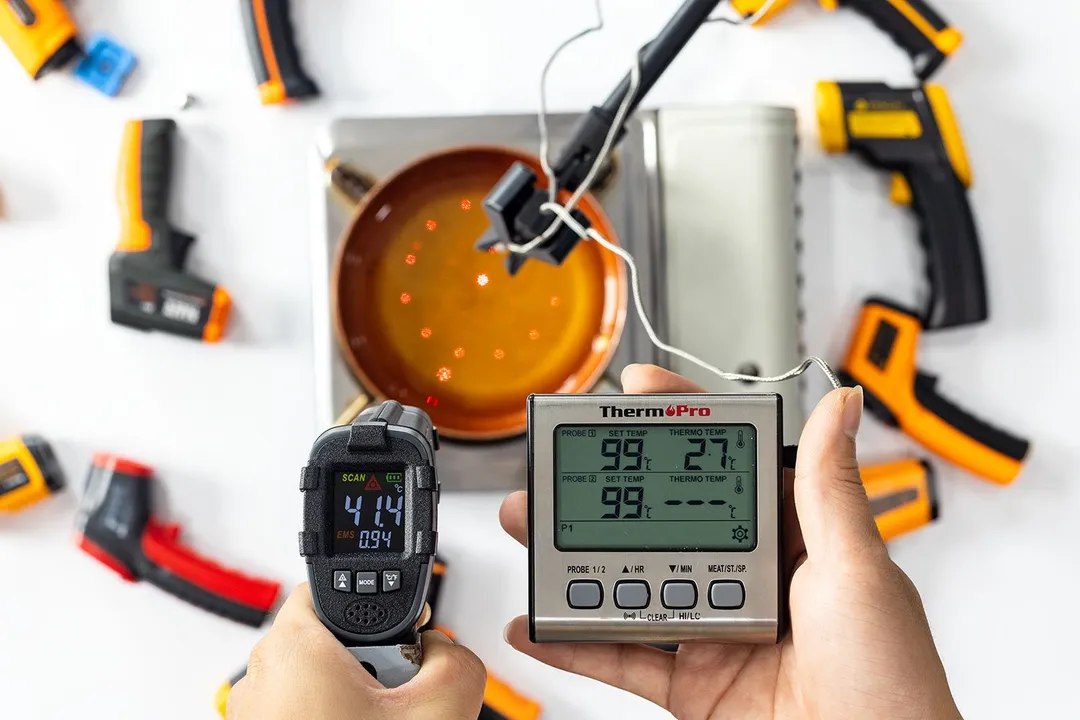
The second test (the hot test) called for cooking oil. Following a similar methodology, we heated a pan of cooking oil on a stovetop and maintained a temperature of 321°F. We took two measurements—one at 12 inches and one at 16 inches from the oil—and compared them to the oil's actual temperature (321°F). The closer the thermometer's readings were to the oil's temperature, the better the performance score.
Our reviewers also assess the design of the thermometer, like the build quality, laser emitter, and the display panel.
A good IR thermometer should also be user-friendly and easy to handle. Consequently, we look into the usability of each model. Specifically, factors such as the handling experience, the number of measurement modes, and whether it includes audio cues.
Check out full How We Test and Score Our Infrared Thermometers for more information.
How We Picked
The top IR thermometers featured in this guide are selected after rigorous testing and evaluation, in accordance to our testing methodology. Those that have higher scores are selected for this list. Our methodology covers all facets of the product, assessing performance, design, and unique features relative to other IR thermometers in the market, giving you all the data you need to make an informed purchase decision!
Our Top Picks
Here’s a round-up of the top IR thermometers we’ve tested in our lab as of June 2024.
1. Best Overall: Eventek ET312 Infrared Thermometer Gun
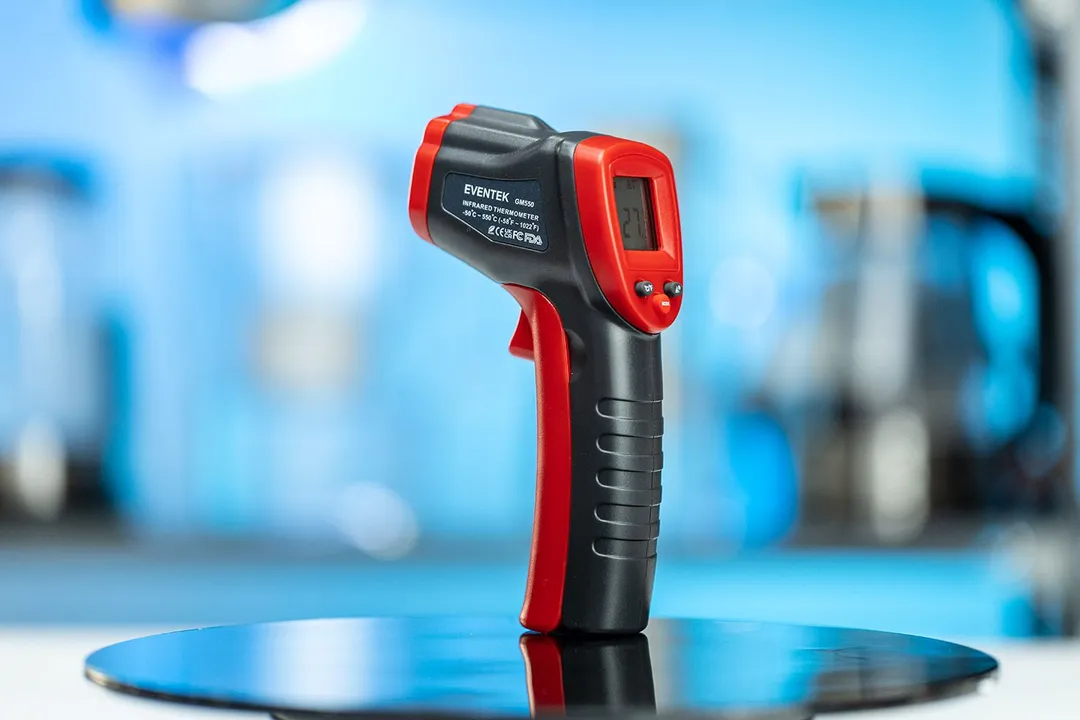
Things We Like
- Affordable
- Great IR sensor that returns accurate readings
- Well-built outer housing and parts
- Handling experience is decent
- Has many measurement modes
- Loud, clear speakers
Things We Don’t Like
- The product looks and feels cheap
- The handle isn’t textured which can make it slippery in wet hands

The Eventek ET312 performed exceptionally in our tests. In the cold test, it measured an ice bath at 32°F, averaging 32.85°F across two sessions. This is impressively close to the ice's temperature, earning it a high score of 8.35 out of 10.
In the hot test, it measured boiling oil at 361°F, with an average reading of 365.2°F, quite close to the actual temperature, resulting in a score of 8.12 out of 10.
Its outstanding performance in both tests led to one of the highest database scores at 8.2 out of 10.
For the price, the build quality of the Eventek ET312 is decent. It’s made from high-quality, but smooth plastic throughout. The lack of texturing could be considered a drawback, since it’d make it harder for the user to grip with wet hands.
Usability-wise, the Eventek ET312 offers four measurement modes, including an EMS mode, to adjust the emissivity setting. It also has a calibration mode to help you fine-tune the IR sensor for better accuracy.
Read our full Eventek ET312 Infrared Thermometer Gun in-depth review
2. Best Runner: Wintact WT530 Infrared Thermometer
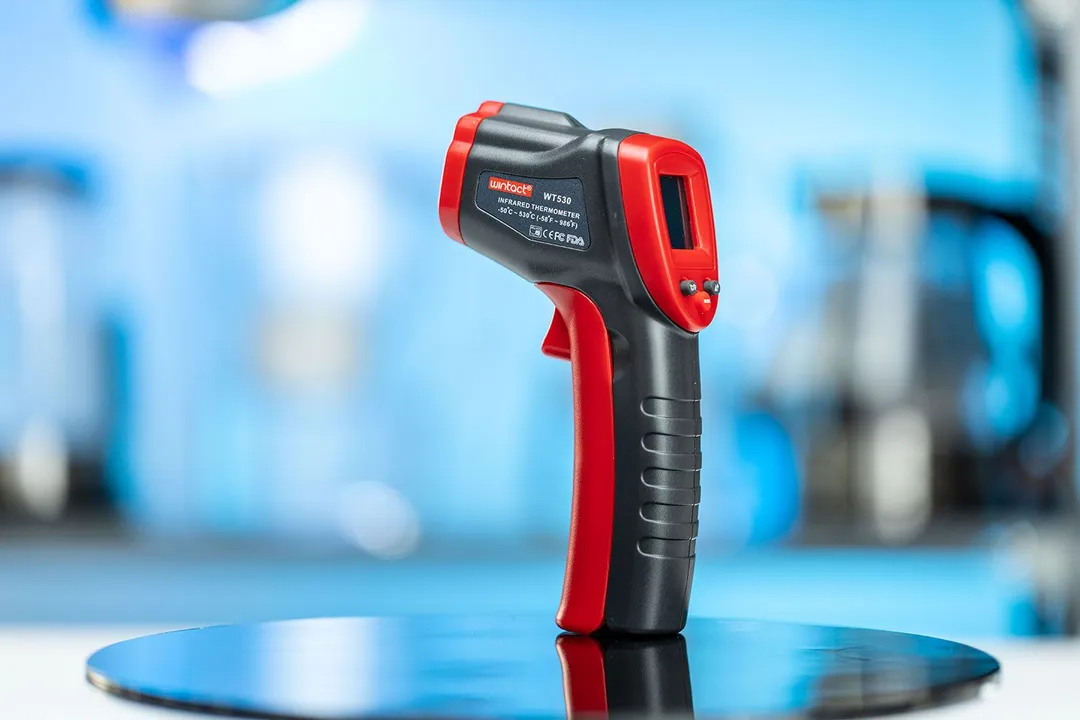
Things We Like
- Moderately affordable
- Very good measurement accuracy
- Multiple measurement modes
- More precise temperature tolerance than other IR thermometers on the market (±1.5°F)
Things We Don’t Like
- The battery compartment has a very loose lid
Second to the Eventek ET312 is the Wintact WT530. It scored just a smidge lower in terms of performance. The only issue we found with the Wintact IR thermometer was its loose-fitting battery compartment door.
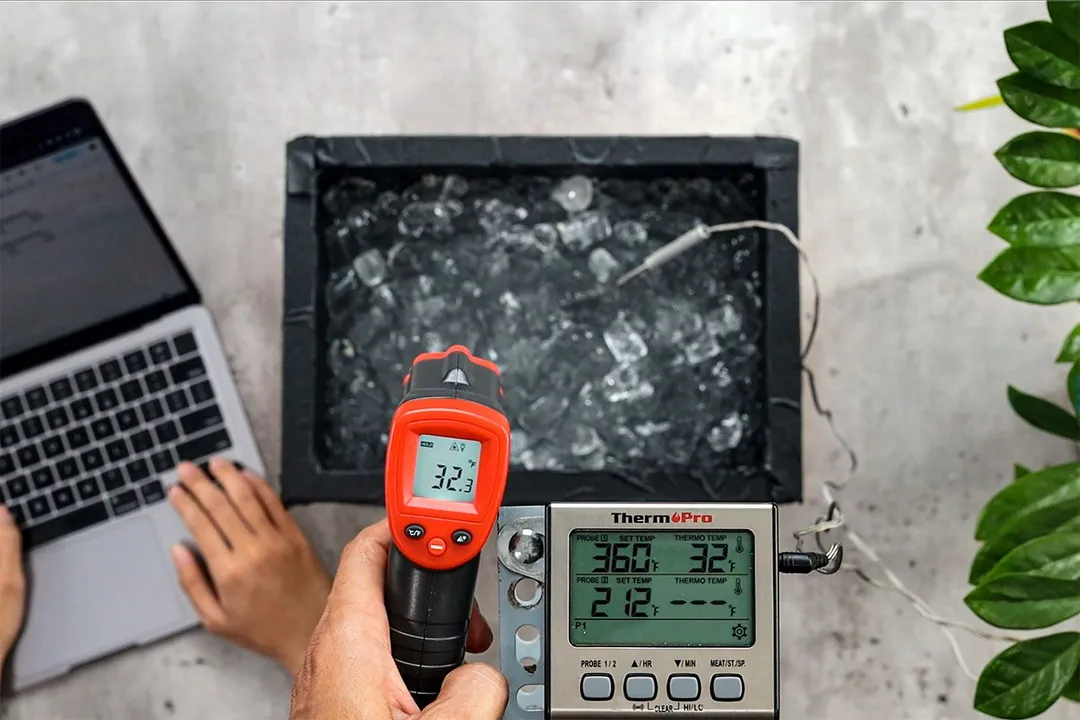
The Wintact WT530 infrared thermometer excelled in the cold test. When measuring a 32°F ice bath, it averaged 32.85°F, earning it a solid score of 8.55 out of 10.
However, it didn’t perform as well in the hot test. While measuring a 361°F pan of oil, it recorded an average of 365.7°F over two test sessions. While this is still reasonably accurate, points were docked from its total score due to the variations in the readings between sessions, earning it a 7.66 out of 10 in this category.
Overall, it secured an impressive 8.0 out of 10, just 0.2 points shy of the top-rated Eventek ET312.
The thermometer’s overall construction is decent, save for the loose battery compartment lid that we found on our unit.
It has four measurement modes in total. You can switch between emissivity of either 0.8 or 0.95, but you can’t flexibly pick values in between. The other modes can display the minimum and maximum readings, as well as a calibration mode.
Read our full Wintact WT530 Infrared Thermometer in-depth review
3. Best Build Quality: Klein Tools IR1 Infrared Thermometer
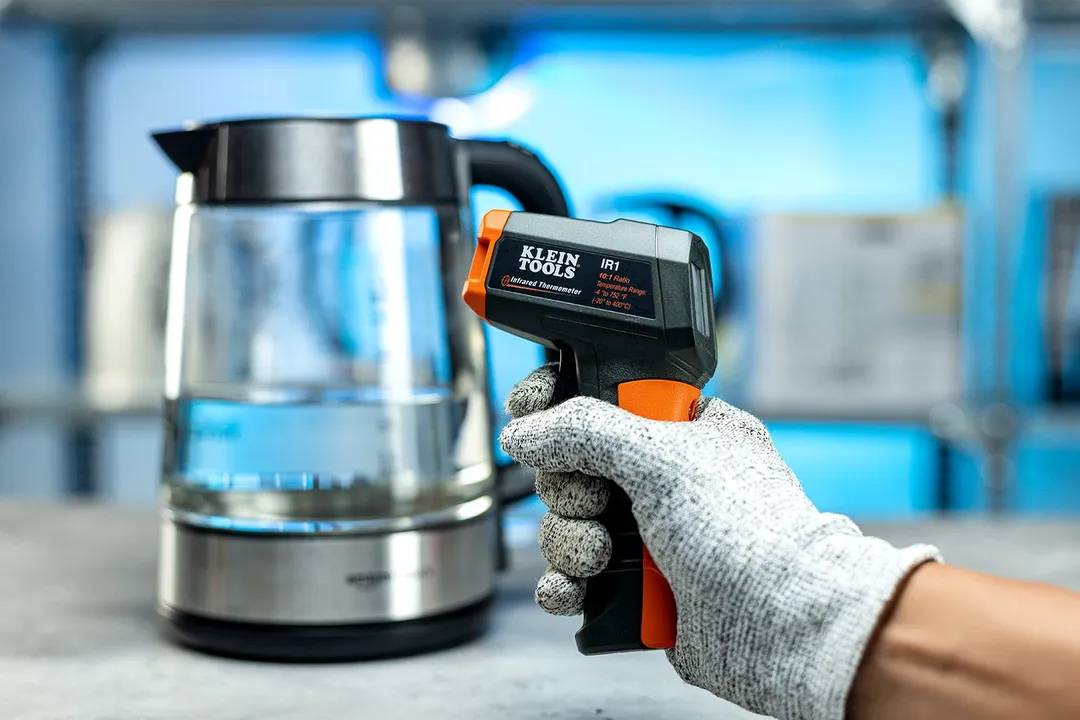
Things We Like
- Rugged, industrial-grade design
- Quality IR sensor provides relatively accurate readings
- Bright laser emitter
- Bright backlit LCD panel
Things We Don’t Like
- Doesn’t come with any extra measurement mode
- A screwdriver is needed to access the measurement unit switch and battery
Besides solid build quality, the thermometer also comes with a holster accessory. That alone will make it an appealing choice for many people, especially outdoor BBQ enthusiasts.
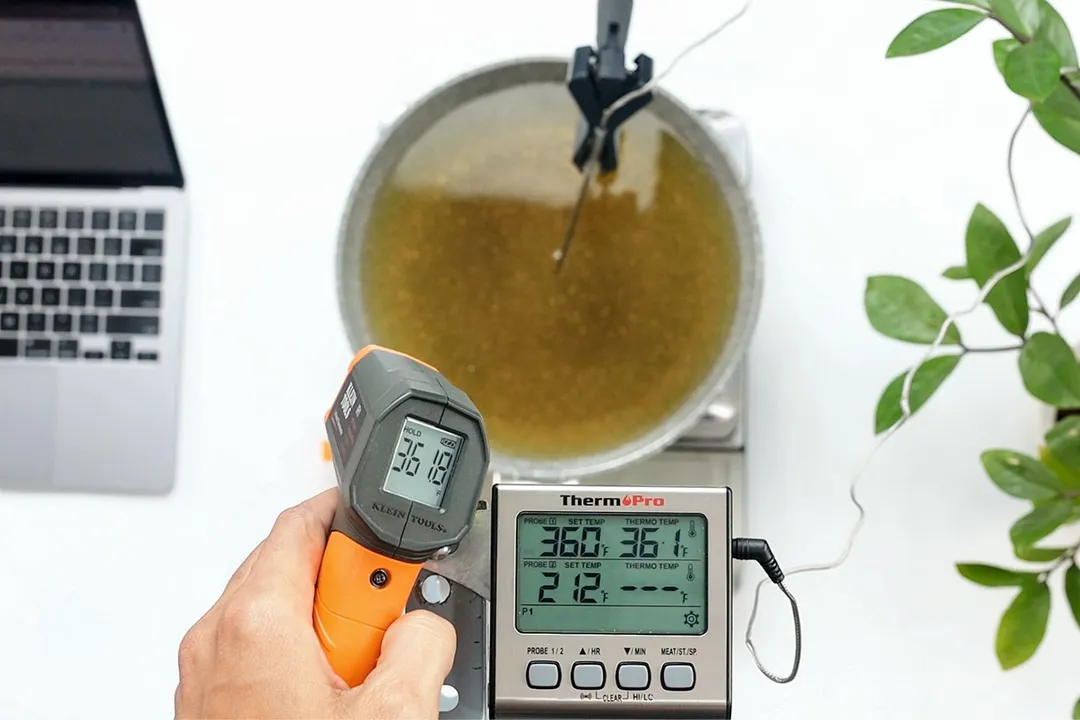
The Klein Tools IR1 thermometer excels in measuring high-temperature surfaces. In the hot test, it recorded an average of 364.4°F against a 361°F hot oil pan, earning a high 8.66 out of 10.
Regrettably, its performance in the cold test wasn't as impressive. While the ice bath was at 32°F, the Klein Tools IR1 registered an average of 30°F. The inconsistent readings resulted in a lower score of 6.7 out of 10.
Despite this setback, the Klein Tools IR1 remains among the top-performing IR thermometers, primarily due to its excellent performance in the hot test. Its overall performance score stands at 7.9 out of 10.
The design of the Klein Tools IR1 is impressive for its price. It boasts excellent build quality. However, there are some questionable design choices, such as the switch to change between °C and °F units being hidden inside a screw-in battery compartment.
The thermometer features a textured grip for easy handling. The Klein Tools IR1 does not offer extra measurement modes or even a speaker for audio signals.
The thermometer features a textured grip for easy handling. The Klein Tools IR1 does not offer extra measurement modes or even a speaker for audio signals.
Read our full Klein Tools IR1 Infrared Thermometer in-depth review
The Competition
- Sovarcate HS980E: Sovarcate HS980E offers solid build quality. Despite not being the top-tier performer, it still achieved decent scores in performance tests. Ideal for those valuing reliability.
- Helect IR thermometer: Despite a few trade-offs like the lack of extra measurement modes, the Helect has some of the best measurement accuracy in our database. Ideal for those seeking the best accuracy on a budget.
Factors to Consider
Picking an IR thermometer seems like straightforward business, but if you want maximum accuracy and value for the money, take a few things into consideration.
First and foremost, measurement accuracy is crucial. Unfortunately, online reviews can't confirm this, but that's where our tests come in.
Additionally, consider the thermometer's emissivity settings for various surfaces and the distance-to-spot (D:S) ratio. A higher D:S ratio allows you to measure from a distance.
Lastly, you'll want a thermometer that’s built to last and easy to use. That means having a clear, user-friendly display, an intuitive interface, and a laser pointer that's both bright and precise.
For a deep dive into choosing the perfect infrared thermometer, you can see our buyer’s guide!
Our Expertise
The reviewer behind this project, Matthew Lee, has had over three years of experience working with Healthy Kitchen 101 on a variety of review projects. Besides IR thermometers, he’s also had a hand in developing our waffle maker testing procedures.
Matthew is part of our Research, Testing, and Review (RTR) Team, responsible for coordinating the logistics of each review session. Test Lead Lap Vo oversees this team and operates under the direct supervision of Luna Regina.
The team dedicated more than 300 hours to brainstorming, refining, and standardizing the testing approach for infrared thermometers. Afterward, we spent an additional 200 hours conducting the tests and organizing the results in a clear and presentable format.
FAQ
Using infrared thermometers is incredibly simple. Just press and hold the trigger, aim the laser pointer at the point you wish to measure, and the temperature reading will instantly appear on the screen. Once you release the trigger, the thermometer will hold the last temperature reading on the screen for your convenience.
Accuracy differs from model to model. Most in our database claim to measure within ±2°F of the actual temperature. You’ll have to read your IR thermometer’s manual for more details.
Emissivity is one of the most important factors. Different materials have their unique emissivity values. Many thermometers give you the ability to change the emissivity setting of the sensor to improve accuracy. Then, there’s the distance between the thermometer and the object matters. This is usually demonstrated by the device's D:S (distance-to-spot) ratio.
Elements like temperature, humidity, and air currents can impact your measurements, as well. Because these are very hard to control, achieving absolute precision with any IR thermometer is often impossible. This is why most models have an "error tolerance," commonly around ±2°F from the actual temperature.
Thermometers designed for measuring body temperature belong to a different product class and have far higher precision.
As a result, IR thermometers intended for industrial or kitchen use explicitly state in their user manuals that they should not be used to measure body temperature.
The greatest advantage of an infrared (IR) thermometer is that you never have to make direct contact with the surface to measure its temperature.
Cheap IR thermometers can provide precise readings within a 1-inch spot from 12-16 inches away. This allows you to monitor the temperature of your grill, stovetop, oven, and other appliances from a safe distance.
Yes, you can use an IR thermometer on liquids. However, keep in mind that it will only be able to measure the surface temperature of the liquid. It won’t be able to tell you the temperature at the bottom or center of the liquid body.
References
https://www.sciencedirect.com/topics/engineering/thermal-radiation - Thermal Radiation
About your guide
Matthew Lee is a writer and editor for HealthyKitchen101. With over 8 years working for various outlets and agencies, specializing in tech review and other subjects of note, such as current affairs.
Luna Regina is an accomplished writer and author who dedicates her career to empowering home cooks and making cooking effortless for everyone. She is the founder of HealthyKitchen101.com and HealthyRecipes101.com, where she works with her team to develop easy, nutritious recipes and help aspiring cooks choose the right kitchen appliances.
Lap is Head of the Research, Testing, and Review Team (RTR Team) at HealthyKitchen101.com, where he directs and supervises the testing of kitchen gadgets and appliances.
Nguyen Ntk is a graphic designer, photographer, and videographer whose philosophy centers around respecting and celebrating the beauty of reality. Through his lenses, Nguyen strives to capture the true essence of objects and events, showcasing and highlighting authentic features without distortion or exaggeration.



